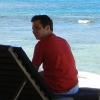
Cancer Knowledge
#151
Posted 21 February 2012 - 01:26 AM
#152
Posted 21 February 2012 - 04:05 PM
#154
Posted 14 March 2012 - 01:10 PM
DCA - switches on mitochondria in tumour cells, removing immortality and possibly killing cancer stem cells.
#155
Posted 14 March 2012 - 02:10 PM
"Blueberry Punch" fights prostate cancer.
http://www.ncbi.nlm....pubmed/22067725
http://jn.nutrition..../140/4/786.full
From the full text of the J. Nut paper:
Blueberry Punch preparation.
Fresh olive leaf, grape seed and skin, citrus skin (orange, mandarin, lemon, kaffir lime, and Tahitian lime), green tea, turmeric, and ginger were juiced individually in a fruit juicer. The individual pulps were extracted with 60–95% ethanol in a ratio of 1:1 in weight for a minimum of 2 wk. The ethanol-based extraction medium facilitates an extraction of both fat-soluble and water-soluble phytochemicals. A stainless steel hydraulic press was used to separate the alcoholic extract from pulp. The resulting enriched extracts were blended and subjected to vacuum distillation to remove the alcohol and most of the water. The extracts were then added to fruit juice concentrate of blueberry and raspberry. The product named Blueberry Punch (BBP) is manufactured by Dr Red Nutraceuticals Pty Ltd (Mt Nebo, Queensland, Australia). See Supplemental Table 1 for major chemicals and their properties.
Lots of our faves in there. Oddly enough, no blueberries! Is a good olive oil equivalent to an olive leaf extract, or is there something special in leaves? Since it was intended to mimic a Mediterranean diet, I'd think so, since people don't eat the leaves, they drink the oil or eat the fruit. The inclusion of citrus skin is kind of a new one for me.
#156
Posted 15 March 2012 - 05:00 PM
#157
Posted 15 March 2012 - 08:13 PM
Prevention of Mutation, Cancer, and Other Age-Associated Diseases
by Optimizing Micronutrient Intake.
http://www.ncbi.nlm....cles/PMC2945683
http://www.hindawi.c...na/2010/725071/
Edited by tham, 15 March 2012 - 08:38 PM.
#158
Posted 16 March 2012 - 01:09 AM
#160
Posted 18 March 2012 - 08:22 PM
Concord grapes fight cancer.
Regular consumption of concord grape juice benefits human immunity.
http://www.ncbi.nlm....pubmed/21138361
Inhibition of rat mammary tumorigenesis by concord grape juice constituents.
http://pubs.acs.org/....1021/jf030278l
Anthocyanin-rich grape extract blocks breast cell DNA damage.
http://www.ncbi.nlm....ubmed/17651059/
Purple grape juice inhibits 7,12-dimethylbenz[a]anthracene (DMBA)-induced rat mammary tumorigenesis and in vivo DMBA-DNA adduct formation.
http://www.ncbi.nlm....pubmed/15878797
Edited by tham, 18 March 2012 - 08:25 PM.
#163
Posted 13 April 2012 - 12:14 AM
http://www.mdpi.com/...-3397/9/8/1428/
#165
Posted 16 April 2012 - 08:58 AM
http://www.ncbi.nlm....pubmed/19003049
#168
Posted 08 May 2012 - 03:17 AM
OTTAWA — A team of University of Ottawa researchers has solved the mystery of how our bodies adapt to low-oxygen environments, raising the prospect that life-threatening conditions such as cancer, stroke and heart disease could someday be successfully treated using a simple, antibiotic-like drug.
The team’s findings were published Sunday in Nature, the world’s leading scientific journal. “It’s a tremendously important discovery in understanding how life without oxygen works,” said Dr. Stephen Lee, a professor in the university’s Department of Cellular and Molecular Medicine, whose laboratory did the groundbreaking research.
Scientists have known for decades that in the presence of oxygen, cells make proteins — the building blocks of life — using a process called protein synthesis. But how they do so in conditions of limited oxygen had remained a mystery.
“There’s a huge amount of research, hundreds of thousands of papers,” Lee said in an interview. “But still nobody has discovered how we make the basic building blocks of life in these conditions. That’s what we discovered.”
Lee’s team found there’s an oxygen-regulated switch in the protein synthesis machinery, a “very novel and unexpected way of synthesizing proteins,” Lee said. “It’s very different.”
The discovery explains, for the first time, how mountain climbers and highland Tibetans are able to adapt and function in environments that would kill or sicken most people.
“These are very basic processes of life,” Lee said. “It’s kind of strange that we discovered this in the 21st century. That tells you there are still basic processes that we just don’t know exist.”
The implications for cancer treatment, though still speculative, are potentially huge. Lee’s team discovered that cancer cells proliferate by using the same protein synthesis machinery the body employs to deal with low levels of oxygen.
Cancer cells “utilize that way of producing proteins without oxygen, even if oxygen is present,” Lee said. “They hijack that system and that drives their proliferation.”
If the cancer cells use the low-oxygen machinery to spread, he said, “we can develop an antibiotic against that protein synthesis machinery. It’s as easy as that. And it’s working very well.”
The comparison to antibiotics is apt, Lee said. Drugs such as penicillin and tetracycline kill bacteria by preventing them from synthesizing proteins. A future cancer drug would “work in a similar fashion,” Lee said, using the low-oxygen machinery to block protein synthesis in cancer cells.
That should make it “very easy to kill cancer cells,” he said. “We’re doing it right now in the lab. We just need to develop a drug now, which is not trivial, but it’s not that difficult, either.”
The sort of cancer treatment imagined by Lee would be a radical departure from the current approach, which relies on toxic doses of chemotherapy and radiation.
“The major dogma right now is that we have to attack cancer cells using very specific drugs that target very specific molecules,” Lee said.
“If we’re right, this is the first systemic difference between a normal and a cancer cell. Rather than targeting one precise molecule, we would just strip the cancer apart by preventing it from making the building blocks.”
Lee hadn’t originally planned to include the reference to cancer treatment in the Nature article “because we thought it was too speculative and Nature is a very conservative journal. But they really asked us to point the possibility out.
“They liked it. I like it. We have data that suggests we’re right. We just need to prove it more and convince some chemists to start working on it.”
The team’s research could also lead to the development of drugs to treat and protect people who have strokes or heart attacks.
Strokes and heart attacks cut off the supply of blood, damaging or killing brain cells or heart tissue. At such times, “our cells just don’t have enough time to adapt to low oxygen,” said Lee.
But as a result of the University of Ottawa team’s discoveries, drugs could be developed that would switch on the alternate protein synthesis machinery within seconds, allowing cells to survive with little oxygen. As well, Lee said preventive drugs could “definitely” be developed for high-risk patients to improve their chances of surviving a stroke or heart attack.
Similar drugs could also be used by mountain climbers and others who operate in low-oxygen environments to eliminate the need for weeks or months of acclimatization.
Lee said papers published about 18 months ago found that the high-altitude Tibetans have a genetic mutation that allows them to survive. “The mutation they have is exactly in the gene that’s involved in my pathway,” he said. “That protein synthesis system is on all the time.
“It’s strange that out of the hundreds of thousands of genes that we have, the one nature selected for the highlanders to live up in the mountains is the one that makes the switch in our system from high oxygen to low oxygen. That’s incredibly interesting.”
Lee first twigged to the existence of an oxygen-regulated switch in 2006 while doing post-doctoral work at the National Cancer Institute in Washington after a former Ph.D. student of his did an experiment.
“We looked at that and said, “Oh-oh, we’re on to something here of big, big, massive proportions,” Lee said. He continued the research after relocating to the University of Ottawa and opening his own laboratory. “Nature published this because we took our time and we figured out the full pathway and really proved it.”
Lee’s team includes Dr. James Uniacke, a post-doctoral fellow who did most of the research, along with graduate students, technicians and others who worked under his supervision.
The team also collaborated with Dr. Martin Holcik, a research scientist at the Children’s Hospital of Eastern Ontario, and Dr. Arnim Pause, of McGill University’s Cancer Research Centre. Both are experts in protein synthesis and provided feedback and analysis of the University of Ottawa team’s research.
#169
Posted 10 May 2012 - 12:30 PM
http://www.ottawacit...4966/story.html
OTTAWA — A team of University of Ottawa researchers has solved the mystery of how our bodies adapt to low-oxygen environments, raising the prospect that life-threatening conditions such as cancer, stroke and heart disease could someday be successfully treated using a simple, antibiotic-like drug.
Very interesting! Good find Mr Happy!
I wonder if extra oxygen, either bottled or from a electrolytic cell would help for cancers?
One also wonders if there is anything to the whole ozone O3 and peroxide H2O2 cure story??
Edit: trimmed excessive quoted text.
Edited by niner, 29 May 2012 - 09:08 PM.
#170
Posted 18 May 2012 - 08:05 PM
that, in humans, are metabolized
by the tumour- specific CYP1B1 enzyme
in cancer cells1-8 to initiate a cascade of
processes, including apoptosis, that result
in the arrest or decline of the cancer.
http://www.wistik.be...chaefer2007.pdf
http://www.salvestro...vestrol_JOM.pdf
Also Mike_nyc posted about em here:
http://www.longecity...id__pid__122956
Googling Salvestrols brings up a site selling them that 'feels' pretty legit and has good info on these bitter phytonutrients.
Edited by Logic, 18 May 2012 - 08:16 PM.
#171
Posted 18 May 2012 - 08:09 PM
http://www.ncbi.nlm....pubmed/17695501
As always; do a pubmed search for more info.
#172
Posted 18 May 2012 - 08:39 PM
Although the special substance, known as HAMLET (Human Alpha-lactalbumin Made LEthal to Tumour cells), was discovered in breast milk several years ago, it is only now that it has been possible to test it on humans. Patients with cancer of the bladder who were treated with the substance excreted dead cancer cells in their urine after each treatment.
http://www.scienceda...00419132403.htm
#173
Posted 24 May 2012 - 09:32 PM
Thioridazine converts cancer stems cells back into normal cells.
#174
Posted 27 May 2012 - 03:28 PM
Gamma rays and x-rays are basically in the same short wavelength spectrum,
and overlap.
http://hyperphysics....hbase/ems1.html
" The gamma ray photon may in fact be identical to an x-ray, since both are
electromagnetic rays; the terms x-ray and gamma rays are statements about
origin rather than implying different kinds of radiation. "
http://hyperphysics....se/ems3.html#c5
" ..... X-ray and gamma rays overlap over a certain range. At this point, the two rays
are identical in terms of EM properties ... "
" As a result, the only difference between ALL x-rays and gamma rays are the origin
of the ray itself. X-rays originate from the electron shell, gamma rays originate from
the nucleus. "
http://wiki.answers....rays_and_X-rays
" .... as shorter wavelength continuous spectrum "X-ray" sources such as linear
accelerators and longer wavelength "gamma ray" emitters were discovered, the
wavelength bands largely overlapped. The two types of radiation are now usually
distinguished by their origin: X-rays are emitted by electrons outside the nucleus,
while gamma rays are emitted by the nucleus. "
http://en.wikipedia.org/wiki/X-ray
" .... ionizing radiation cause DNA double strand breaks at a rate of 35 double strand breaks
per cell per Gray,[49] and removes a portion of the epigenetic markers of the DNA,
which regulate the gene expression. At the radiation doses, which typical CT scans
impose, a DNA molecule of 40%-100% of the irradiated cells is damaged by one or more
double strand breaks. This insult is followed by an effort of the cell in attempt to repair
the damaged and broken DNA, however, the repair process is not perfect,[51] and faults
that are not properly repaired can cause the cell to stray from its original design of
operation. The improper operation can manifest in cell death, cancer, and in other puzzling
health conditions, as can be expected from an operation, which randomly alter cell's DNA,
and epigenetic markers.[52] A portion of the population possess a flawed DNA repair
mechanism, and thus suffer a greater insult due to exposure to radiation. "
http://en.wikipedia....ay#Health_risks
Herbert Adams' BEIR VII Phase 2 Study :
Even Low Exposure To X-Rays, Gamma Rays Increases Cancer Risk
" For boys, radiation exposure in the first year of life produces three to four times
the lifetime cancer risk as exposure to the same dose between the ages of 20 and 50.
Female infants have almost double the risk as male infants. "
" For women, the risks of developing cancer after exposure to radiation were 37.5 percent
higher than for men. The risks for all solid tumors, such as lung and breast tumors,
when added together, were almost 50 percent greater for women than for men. "
http://www.scienceda...51027090539.htm
The BEIR VII Phase 2 Study :
HEALTH RISKS FROM EXPOSURE TO LOW LEVELS OF IONIZING RADIATION
http://www.nap.edu/o...isbn=030909156X
#175
Posted 29 May 2012 - 06:43 AM
#176
Posted 30 May 2012 - 03:51 AM
Increased vitamin D3 levels
http://www.ncbi.nlm....pubmed/22623648
melatonin:
http://www.ncbi.nlm....pubmed/22612707
PSK mushroom extract:
http://www.ncbi.nlm....pubmed/22552778
Sulforaphane from broccoli:
http://www.ncbi.nlm....pubmed/22552778
Artemisinin:
http://www.ncbi.nlm....pubmed/22552778
Avemar:
http://www.avemar.com/what_is_avemar
Avogen:
http://www.avogenusa.com/
I've heard good things about oleander too, but haven't taken that personally
http://www.ncbi.nlm....pubmed/21772753.
Edited by PGN, 30 May 2012 - 04:04 AM.
#178
Posted 05 June 2012 - 10:22 PM
http://www.ncbi.nlm....pubmed/15865490
Tien Hsien Liquid Composition
Name / Proportion / Effect
Radix Ginseng 12.5%
Great tonic, reinstating circulation and innervation, alimenting, respiratory, salivant and sedative.
Radix Astragali 15%
Functioning, astringent, diuretic, detox, and sore healing
Cordyceps 24%
A tonic for lung, kidney, hemostatic and expectorant.
Ganoderma 17%
Regulating, defensing, tonic and anti-aging
Rhizoma Dioscoreae 11%
Alimenting, salivant, lung and kidney tonic and sperm keeping.
Herba Scutellariae Barbatae 2%
Clears heat and toxin, activates blood circulation and removes blood-stasis, promotes diuresis.
Margarita 4%
Calming liver and catabolism, sedating and sight helping.
Fructus Lycii 9%
A tonic for liver and kidney, reproduction and sight.
Fructus Ligustri Lucidi 0.5%
A tonic for liver, kidney and sight and hair darkening.
Radix Glcyrrhizae 5%
Alimenting, functioning, defervescent, detox, expectorant, antitussive, and formula harmonizing.
Other ingredients
Water, Honey, Sorbic Acid
#179
Posted 06 June 2012 - 10:18 PM
http://www.biomedcen.../1471-2407/5/97
2 user(s) are reading this topic
0 members, 2 guests, 0 anonymous users












































